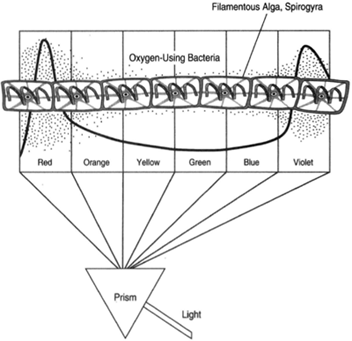Light
Light that passes through or is reflected by a leaf cannot contribute energy to the photosynthetic process; only light that is absorbed by the leaf can contribute to photosynthesis. The light most readily absorbed by leaves is red or blue-violet light; these wavelengths are most responsible for the manufacture of carbohydrate from carbon dioxide and water. |
| Figure 9-8 The Engelmann experiment. A filamentous alga such as Spitvgyra is exposed to a spectrum of light. Bacteria that thrive in an environment of higher oxygen concentration migrate to the red and blue portions of the spectrum, where increased photosynthesis releases more oxygen. |
In 1882 T.W. Engelmann devised a clever and incredibly small demonstration. He placed a filamentous green alga in a solution rich in a form of bacteria that are attracted to oxygen. He then exposed the algal filament to a tiny spectrum of colors. Figure 9-8 shows both how the experiment was set up and what was observed. One part of the filament was exposed to violet light, another part to blue, another to green, and so forth all the way to red light. The oxygen-seeking bacteria clustered mostly in the violet and red zones, and it was from these regions that the most oxygen was liberated. In other words, most photosynthesis took place at these wavelengths.
photosynthesis at various light intensities. Starting with dim light and increasing light intensity, Blackman discovered that while increasing the intensity of light did increase rate of photosynthesis, no increase occurred above a certain intensity. He then determined that it was the temperature increase brought on by bright light that accelerated the rate of photosynthesis. Seeing that the reactions were temperature sensitive led Blackman to conclude that such reactions are governed by enzymes.
Chlorella, a one-celled green protist, is a favored organism in studies of photosynthesis. Laboratory experiments with Chlorella show that photosynthesis efficiency increases when light is alternately turned on and off. This does not mean that more photosynthesis takes place in a given unit of time; rather, more photosynthesis takes place pear mount of light used.
This and other observations led to the understanding that a series of reactions occur in the course of photosynthesis, that some reactions are light dependent, and that some do not require light. These reactions have been termed light reactions and dark reactions. The name dark reaction is in a sense an unfortunate misnomer because it suggests requiring darkness. The so-called dark reactions take place in light; but they are not light dependent. The conversion of carbon dioxide and water into carbohydrate is accomplished by a number of intermediate compounds, and it was tot he dark reactions that Blackman referred when he concluded that certain changes were controlled by enzymes.




